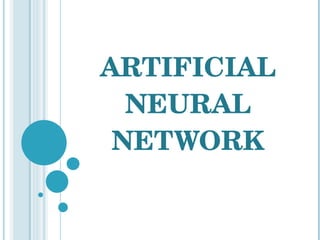Report
Share

Recommended
Recommended
More Related Content
What's hot
What's hot (20)
Radial basis function network ppt bySheetal,Samreen and Dhanashri

Radial basis function network ppt bySheetal,Samreen and Dhanashri
Artificial Neural Networks Lect3: Neural Network Learning rules

Artificial Neural Networks Lect3: Neural Network Learning rules
Lecture 18: Gaussian Mixture Models and Expectation Maximization

Lecture 18: Gaussian Mixture Models and Expectation Maximization
Similar to Back propagation
Similar to Back propagation (20)
Web Spam Classification Using Supervised Artificial Neural Network Algorithms

Web Spam Classification Using Supervised Artificial Neural Network Algorithms
AILABS - Lecture Series - Is AI the New Electricity? Topic:- Classification a...

AILABS - Lecture Series - Is AI the New Electricity? Topic:- Classification a...
Web spam classification using supervised artificial neural network algorithms

Web spam classification using supervised artificial neural network algorithms
SLIDING WINDOW SUM ALGORITHMS FOR DEEP NEURAL NETWORKS

SLIDING WINDOW SUM ALGORITHMS FOR DEEP NEURAL NETWORKS
More from Nagarajan
More from Nagarajan (15)
Recently uploaded
Mehran University Newsletter is a Quarterly Publication from Public Relations OfficeMehran University Newsletter Vol-X, Issue-I, 2024

Mehran University Newsletter Vol-X, Issue-I, 2024Mehran University of Engineering & Technology, Jamshoro
God is a creative God Gen 1:1. All that He created was “good”, could also be translated “beautiful”. God created man in His own image Gen 1:27. Maths helps us discover the beauty that God has created in His world and, in turn, create beautiful designs to serve and enrich the lives of others.
Explore beautiful and ugly buildings. Mathematics helps us create beautiful d...

Explore beautiful and ugly buildings. Mathematics helps us create beautiful d...christianmathematics
Recently uploaded (20)
Vishram Singh - Textbook of Anatomy Upper Limb and Thorax.. Volume 1 (1).pdf

Vishram Singh - Textbook of Anatomy Upper Limb and Thorax.. Volume 1 (1).pdf
Food safety_Challenges food safety laboratories_.pdf

Food safety_Challenges food safety laboratories_.pdf
Salient Features of India constitution especially power and functions

Salient Features of India constitution especially power and functions
UGC NET Paper 1 Mathematical Reasoning & Aptitude.pdf

UGC NET Paper 1 Mathematical Reasoning & Aptitude.pdf
Mixin Classes in Odoo 17 How to Extend Models Using Mixin Classes

Mixin Classes in Odoo 17 How to Extend Models Using Mixin Classes
Fostering Friendships - Enhancing Social Bonds in the Classroom

Fostering Friendships - Enhancing Social Bonds in the Classroom
This PowerPoint helps students to consider the concept of infinity.

This PowerPoint helps students to consider the concept of infinity.
Explore beautiful and ugly buildings. Mathematics helps us create beautiful d...

Explore beautiful and ugly buildings. Mathematics helps us create beautiful d...
Back propagation
- 2. BACK PROPAGATION PRESENTED BY Karthika.T Nithya.G Revathy.R
- 5. FEED FORWARD NETWORK Network activation flows in one direction only: from the input layer to the output layer, passing through the hidden layer. Each unit in a layer is connected in the forward direction to every unit in the next layer.
- 18. Lego Mindstorms robots are cool toys used by hobbyists all around the world. They prove suitable for building mobile robots and programming them with artificial intelligence.
- 28. A. Face Image Acquisition To collect the face images, a scanner has been used. After scanning, the image can be saved into various formats such as Bitmap, JPEG, GIF and TIFF. This FRS can process face images of any format. B.Filtering and Clipping The input face of the system may contain noise and garbage data that must be removed. Filter has been used for fixing these problems. For this purpose median filtering technique has been used. After filtering, the image is clipped to obtain the necessary data that is required for removing the unnecessary background that surrounded the image.
- 42. RECOGNITION 1.Screen to display the selected leaf1. 2.Screen to display the edge and tokens of the selected Leaf1 3.Screen to display the Leaf Image1. 4.Screen to display the results of the Recognition module. 5.Screen to display the leaf image for finding pest recognition. 6.Screen to display the Pest Percentage of the given leaf and also the damage part.
- 44. THANK YOU
